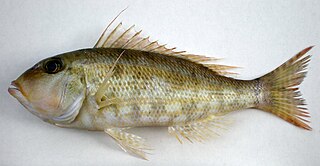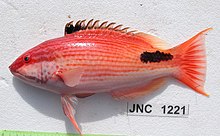
The daggertooth pike conger also known as the darkfin pike eel in Australia, to distinguish it from the related pike-eel, is a species of eel in the pike conger family, Muraenesocidae. They primarily live on soft bottoms in marine and brackish waters down to a depth of 800 m (2,600 ft), but may enter freshwater. They commonly grow to about 1.5 m (4.9 ft) in length, but may grow as long as 2.2 m (7.2 ft). Daggertooth pike congers occur in the Red Sea, on the coast of the northern Indian Ocean, and in the West Pacific from Indochina to Japan. A single specimen was also reported in the Mediterranean Sea off Israel in 1982.

The Anisakidae are a family of intestinal nematodes (roundworms). The larvae of these worms can cause anisakiasis when ingested by humans, in raw or insufficiently cooked fish.

Like humans and other animals, fish suffer from diseases and parasites. Fish defences against disease are specific and non-specific. Non-specific defences include skin and scales, as well as the mucus layer secreted by the epidermis that traps microorganisms and inhibits their growth. If pathogens breach these defences, fish can develop inflammatory responses that increase the flow of blood to infected areas and deliver white blood cells that attempt to destroy the pathogens.

Huffmanela branchialis is a parasitic nematode It has been observed on the gills of the fork-tailed threadfin bream Nemipterus furcosus, a nemipterid marine fish off New Caledonia. Its eggs are released from the gill mucosa with the turnover of living tissues and immediately continue their life-cycle.

Huffmanela filamentosa is a parasitic nematode It has been observed on the gills of the lethrinid fish Gymnocranius oblongus and Gymnocranius grandoculis off New Caledonia. Its eggs are released from the gill mucosa with the turnover of living tissues and immediately continue their life-cycle.

Huffmanela is a genus of parasitic nematodes, belonging to the family Trichosomoididae.

Huffmanela lata is a parasitic nematode. It has been observed on the skin of the grey reef shark Carcharhinus amblyrhynchos off New Caledonia. This species has only been reported once in the scientific literature.

Lethrinus atkinsoni is a species of emperor fish described by Alvin Seale in 1910. It is commonly 30 to 35 cm long with a bluish-grey, yellowish, or tan in colour, and a white belly. This species is widespread throughout the west Pacific Ocean. It is a reef-associated fish and is non-migratory. It is solitary or is found in small schools, and lives in seagrass beds and over the sandy bottoms feeding on plankton, mollusks, crustaceans, and other fishes. This fish is caught by humans for food, but less so than other species in the genus due to its small size.

Lethrinus lentjan is a species of emperor fish. It has a distinctive blood-red colouration around the margin of the gill covers. It is widespread around the Indo-West Pacific, and is reef-associated. This species is fished commercially and for sport.

Lethrinus rubrioperculatus, common names the spotcheek emperor, red-eared emperor, red-ears, red-edged emperor, scarlet-cheek emperor, and spot cheek emperor, is a species of emperor fish.

Philometra is a genus of nematodes, which are parasites of marine and freshwater fishes. The genus was erected by Oronzio Gabriele Costa in 1845.

Huffmanela hamo is a parasitic nematode. It has been observed in the muscles of the dagger-tooth pike conger Muraenesox cinereus, a muraenesocid marine fish off Japan. Its life-cycle is unknown.

Pseudorhabdosynochus is a genus of monopisthocotylean monogeneans, included in the family Diplectanidae. The type-species of the genus is Pseudorhabdosynochus epinepheli .

Philometra lethrini is a species of parasitic nematode of fishes, first found off New Caledonia in the South Pacific, in the gonads of Lethrinus genivittatus. This species is characterized mainly by: length of spicules and length and structure of its gubernaculum; structure of male caudal end; body size; location in host and types of hosts.
Philometra lagocephali is a species of parasitic nematode of fishes, first found off New Caledonia in the South Pacific Ocean in the abdominal cavity of Lagocephalus sceleratus. This species is characterized mainly by the length of its spicules, length and structure of its gubernaculum, body size, location in host and types of hosts.

Philometra fasciati is a species of parasitic nematode of fishes, first found off New Caledonia in the South Pacific, in the gonads Epinephelus fasciatus. This species is characterized mainly by: length of spicules and length and structure of its gubernaculum; structure of male caudal end; body size; location in host and types of hosts.

Bodianus busellatus is a species of wrasse native to tropical and warm temperate waters of the south central Pacific, particularly the Marquesas Islands. This species was described by Martin F. Gomon of the Australian Museum in 2006 with the type locality given as northeast of Matakumu Point on Fatu Hiva in the Marquesas Islands. This species is found only in the Marquesas and Pitcairn Islands.

Cucullanus is a genus of parasitic nematodes. The genus includes more than 100 species.

Hamacreadium cribbi is a species of digenean, parasitic in the lethrinid fish Lethrinus miniatus. The species was collected off New Caledonia.

František Moravec is a Czech parasitologist who specialises on the Nematodes, especially the nematodes parasites of fishes. His research is mainly in the field of taxonomy of the Nematoda.




















